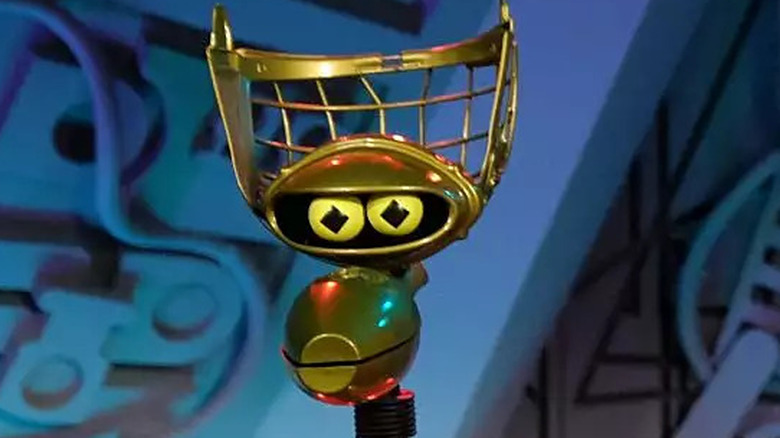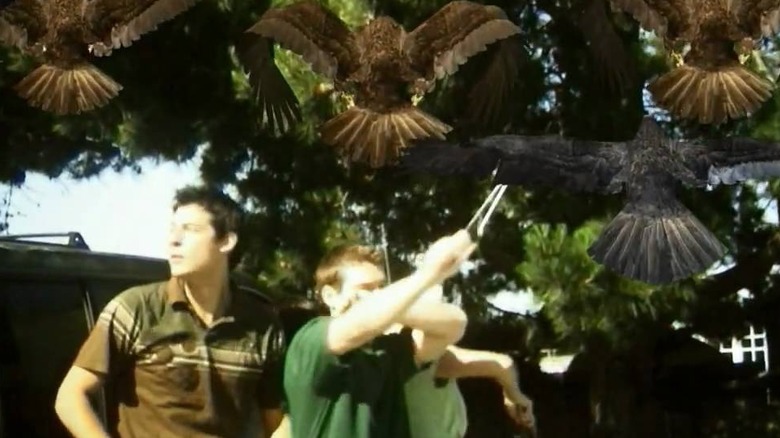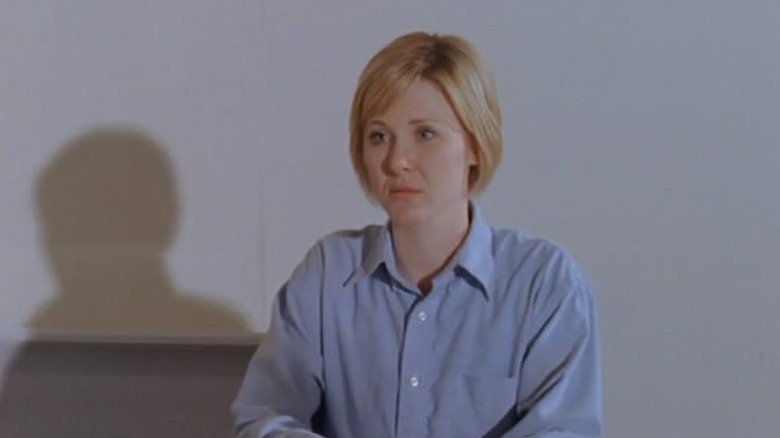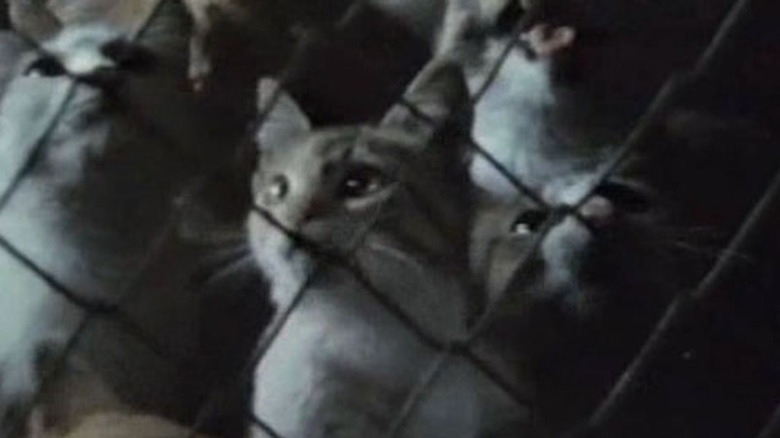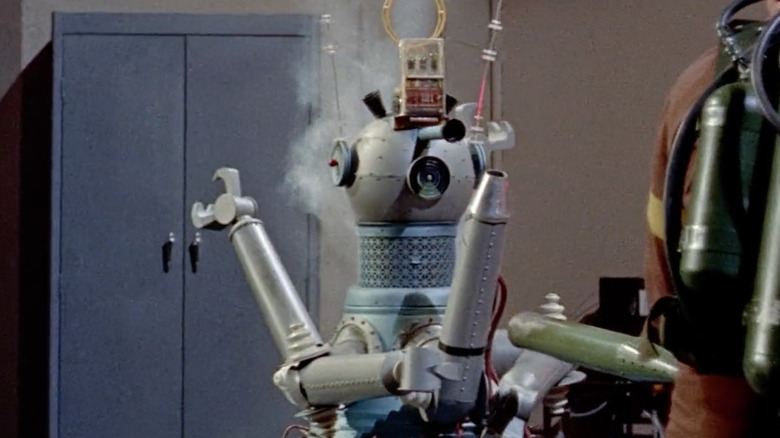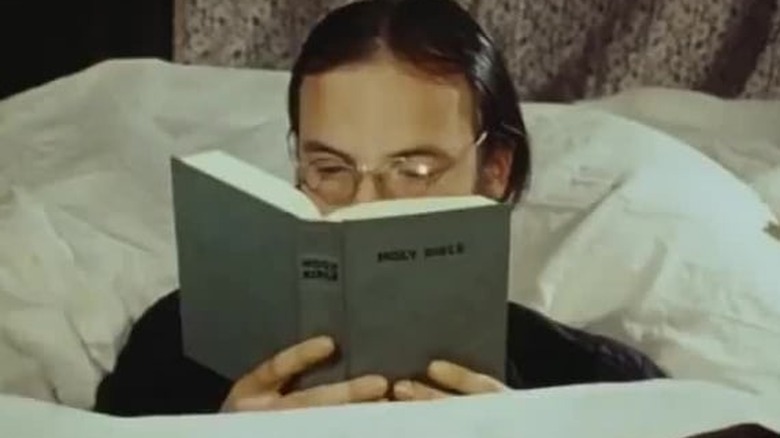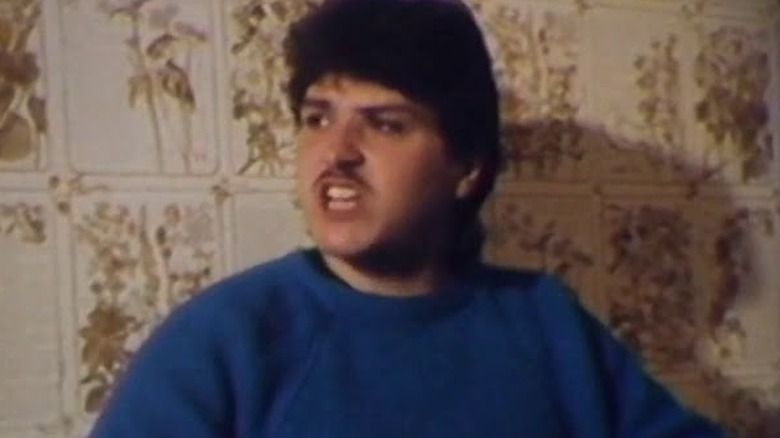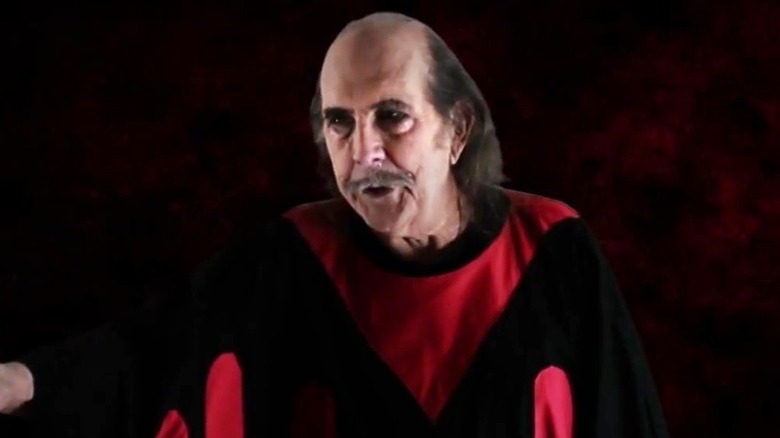Movies That Deserve To Be Riffed By Mystery Science Theater 3000
"Mystery Science Theater 3000" humbly began life as a public access show in Minneapolis in the late '80s before becoming one the longest running, and influential, cult sci-fi franchises in history. Created by former stand-up comedian Joel Hodgson, the series was about a hapless but inventive factory worker named Joel Robinson (played by Hodgson himself) forced to watch bad movies in space on the ship "Satellite of Love" (S.O.L., get it?), at the behest of an evil mad scientist. To keep his sanity, Joel created two robots — the excitable Crow T. Robot and the sardonic Tom Servo — to help make fun of the bad movies with him.
During the course of the show's long run different hosts took over the reins, most recently comedians Jonah Ray and Emily Marsh on the newly crowd-funded "Mystery Science Theater 3000" steaming service, The Gizmoplex.
The decades-long run of the series' various incarnations (and subsequent offshoots like RiffTrax and Cinematic Titanic) have had a profound impact on nerd, comedy, and popular culture in general, with many comedians, internet personalities, and critics citing "MST3K" as a direct influence. Furthermore, many of the films originally riffed on the show — such as the (at the time) forgotten horror flicks "Manos: The Hands of Fate" and "Hobgoblins" — have been given an otherwise unlikely opportunity to be revived by new generations as cult classics.
So, where do things go from here? Whether via Gizmoplex or someplace else, here are some movie titles perfect for the "MST3K" treatment.
Fateful Findings (2013)
Former real estate agent-turned-auteur filmmaker Neil Breen has made five films in total, each more insane than the last — including a five film retrospective. But probably the most (relatively) famous of these films is 2013's "Fateful Findings."
The story follows a famous author (played by Breen) who gets into a car accident that grants him magical powers (or they were granted to him from a weird rock he found as a kid ... it's not really clear.) While most of the film is a domestic drama concerning two groups of crumbling marriages, as well as random intervals of computer hacking (which consists of Breen haphazardly bashing on laptops that are obviously not turned on), the last act has the author magically forcing politicians and corporate CEOs to brutally kill themselves in increasingly cartoon-y ways.
Beyond its nonsensical story, the film is technically incompetent in all the best ways. From terrible After Effects plug-ins (badly composited into digital cinematography that resemble infomercials for dietary supplements shown at 3am) to "mystical artifacts" that could be bought at a 99 Cent Store, the film is perfect for "MST3k"-style riffing.
Double Down (2005)
Another Neil Breen joint, "Double Down" might be his most interesting (as well as most technically incompetent). This wouldn't be the first time "Mystery Science Theater 3000" has done multiple bad films from the same bad filmmaker, including three classic episodes devoted to films directed by Coleman Francis ("Red Zone Cuba", "The Skydivers" and "The Beast of Yucca Flats").
The plot of "Double Down" is, somehow, even more inscrutable than "Fateful Findings." The film follows an on-the-run super hacker and highly-decorated super-soldier named Aaron Brand (obviously played by Breen), hired by a foreign government to single-handedly shut down Las Vegas, while simultaneously being hired by the US to stop a terrorist (who is actually just himself). During the course of the film, Brand gets spiritual visions of his dead wife and parents — as well as possibly, the literal spirit of America.
The constant use of stock footage brings to mind classic schlockmeisters like Ed Wood or Roger Corman; there's an earnestness to Breen's madness, however, that is all his own. The constant spiritual visions and the film's apparent back-and-forth about if those visions or real are all in his head would be compelling if executed by a more competent filmmaker. Luckily, it wasn't.
Birdemic: Shock and Terror (2010)
Alfred Hitchcock has long been known as "The Master of Suspense", but director James Nguyen has been dubbed (by himself) as "The Master of the Romantic Thriller ™" with his 2010 horror film "Birdemic: Shock and Terror", an homage to the Hitchcock classic "Rope."
"Birdemic" is one of the most technically inept films you could ever find, from terrible special effects (such as the CG birds that look like mid-90's GeoCities gifs) to atrocious acting (Alan Bagh's delivery as protagonist Rod is so wooden he's practically spitting out splinters after every line) to the worst editing ever put on screen.
But, worse than that, is how long it takes the titular "birdemic" to actually commence — after nearly an hour, over half the runtime. Before that, the audience is forced to watch the most boring people imaginable attempt to date, which in practice is like witnessing two auto-generated dating profiles talk to each other, badly. Slightly making amends for this torture is that once the birds do show up, their main form of attack is dive bombing to the ground — with accompanying WWII plane sound effects — and literally exploding.
While RiffTrax (which consists of former "MST3K" cast members) has, well, riffed this and some of the ensuing movies, doubling up has happened before (i.e. multiple "Manos: The Hands of Fate" commentaries), and sometimes it's just fun to see different crews come up with new jokes. With a film like this, the well is in no danger of running dry.
After Last Season (2009)
"After Last Season" could be best described as "Nothing Happens: The Movie." While there is ostensibly a plot, even a theoretically interesting one, watching the film itself isn't even like watching paint dry — because at least the act of drying means something is happening.
The film is supposedly about a murder at a university that needs to be solved by two students using an experimental computer/VR program to reconstruct the crime scene. This gets overly explained to the point of tedium (while still not making any sense), and frequently comes across like an art film made by elementary school students in terms of its amateurish filmmaking style and cheap production values.
There's a hospital scene, for instance, that has clearly been shot in someone's house — no attempt is made to hide the carpeted floors or hanging ceilings fans. This is augmented with CGI that looks like a Windows 1.0 screensaver, and FBI agents whose logos appear to have been made from yellow construction paper.
Even crazier is the reported $5 million dollar budget, which certainly didn't make it onto the screen and seems to raise questions about where it all went. Rest assured, the "MST3K" could make "After Last Season" far more entertaining to watch than the filmmakers did.
A Talking Cat!?! (2013)
Director David DeCoteau has been a premiere schlockmeister since the '80s, helming such fun, sleazy cult classics as "Sorority Babes in the Slimeball Bowl-O-Rama", "Revenge of the Babes", and countless more (often under aliases). In the early 2010's, however, he took a hard left turn from making terrible, borderline softcore films into instead making terrible, borderline incomprehensible children's films. One of his most high-profile attempts at the genre was the disastrous "A Talking Cat!?!" — and yes, all that gratuitous punctuation is indeed in the title.
Starring Eric Roberts as the titular speaking feline (it sounds like his dialogue was recorded on a twenty-year-old Walkman in the actor's bathroom), the cat is supposed to be a fun, charming Marry Poppins-esque facilitator of magic and whimsy; instead, it sounds like a belligerent biker. This is piled on top of some terrible VFX (where the cat's "talking mouth" effect looks like it was done in MS Paint), and the obvious use of laser pointers to solicit its attention. Unfortunately, the viewer doesn't get anything nearly as entertaining to watch.
The "MST3K" crew could have a field day with such matters — as well as a nonsensical story that has Duffy the cat dispensing "magical advice" to humans that includes such pearls as "check your voicemail" and "go for a walk."
Night of 1,000 Cats (1972)
Speaking of cats, the 1972 Mexican exploitation film "Night of 1,000 Cats" (also known as "La noche de los mil gatos" and, for some reason, "Blood Feast") is about a psychotic millionaire who throws his female victims into a pit of hungry cats — which somehow turns the women into ground beef that looks like what you'd buy at the supermarket.
There's honestly not much more story than that — just a string of vignettes that lead to cat food, fueled by organ music. Also, the film lasts more than one night, so there's that. The main killer/cat feeder Hugo (Hugo Stiglitz) fancies himself a suave guy, and his preferred method of flirting is piloting a helicopter in front of women — resulting in so much helicopter footage you'd think the film was reporting on the Vietnam War.
Since the runtime for "Cats" is so short (barely an hour), the Satellite of Love could accompany it with some well-selected shorts; often, such clips are the highlight of an "MST3K' episode.
Gog (1954)
A staple of "Mystery Science Theater 3000" selections has always been cheesy '50s sci-fi flicks, from "Robot Monster" to "Project Moon Base" to 1955's "This Island Earth" (which served as the basis for "Mystery Science Theater 3000: The Movie"). What makes such films ripe for dissection are their low-budget effects, outdated social norms, and wonky, overly-convoluted techno-babble; the Herbert L. Strock obscurity "Gog" similarly checks all those boxes.
The story itself is actually interesting, following a government agent who is investigating murders at a secret underground science base. When he finds out that the robots meant to assist in building a space station there (named Gog and Magog, hence the title) have gone rogue and started killing people, a plan is quickly devised to stop them.
The problem with the film, unfortunately, is in the execution. From goofy robots that meant to be threatening but resembling cute toys to cheap cardboard sets that wobble as the actors run through them, there are a lot of unintended laughs here. Of course, the rampant '50s sexism (one female scientist walks around a base under construction in open-toed high heels, while everyone else wears sensible boots) doesn't help.
Death Bed: The Bed That Eats (1977)
Everyone thinks water beds were the big '70s fad, but what few recall is eating beds because ... well, they were only a thing in this movie. Believe it or not, the film is even crazier than the premise sounds on paper.
Since a bed can't be a terribly active antagonist (the victims have to willingly sleep on it), "Death Bed" is limited in how it can orchestrate its kills. Also, when you think of a bed that eats people, you might imagine it has teeth; the Death Bed just has them sink into its stomach acid. At one point, it even gets a tummy ache and needs medicine to calm it down (yes, this is an actual plot point in the film). Talk about a Maalox moment.
The actual story — or, what little there is — concerns a demon who possesses the bed, making it awaken every ten years to feast on victims. The "MST3K" gang would be wise to not sleep on this one.
The Amazing Bulk (2012)
Based on the cover and synopsis for this, you might expect a standard superhero mockbuster in the vein of Asylum's "Almighty Thor" or "Avengers Grimm: Time Wars," cheap, boring, largely forgettable cash grabs tip-toeing around the grey area between public domain, satire and copyright.
But "Bulk" gets dangerously close to touching the third rail of the IP it's clearly ripping off. It's about a well-meaning scientist (played by an actor who looks like he could be the lead singer for a Creed cover band) who turns into a giant raging (purple) monster that fights bad guys while on the run from his girlfriend's military father. But rather than being entertained, the side effect of watching "Bulk" is feeling like you've been beset by a fever dream from binging Ang Lee's "Hulk" and Robert Rodriguez's "Spy Kids" films at the same time while indulging in the illegal substance of your choosing.
The whole thing is inexplicably shot in front of green screens, rendered with cheaper-than-cheap CG backgrounds that look like they belong in a SEGA CD-ROM game or a Tim and Eric show. Even worse, the Amazing Bulk himself is barely in the film (but he is naked, and in one appearance somebody screams "[That sure isn't] Barney the purple dinosaur!"). It's all capped off with a finale full of random CG clip art to pad out the runtime to barely feature length; "MST3K," when you're planning your next purchase of rights for movies to mock, don't forget to buy in "Bulk."
Things (1989)
While "Manos: The Hands of Fate" is largely considered the worst film the "Mystery Science Theater 3000" crew has ever had to endure, "Things" might actually be a real contender for "worst movie ever," if not the throne of "Manos."
"Things" came out at the tail end of the "Canuxploitation" phenomenon of the mid-'70s, where a boon of genre films (especially horror) were made in Canada as tax shelters. The story concerns two guys, Don (writer Barry J. Gillis) and Fred (Bruce Roach), who drive up to annoy Don's brother Doug (Doug Benson) at his house in the middle of the woods. Unbeknownst to Don and Fred, Doug's wife has recently undergone some unorthodox experiments to help her get pregnant; when she dies giving birth to cheap, paper mache monsters (i.e. the titular "things"), they attack and try to eat everyone they can find.
The film looks cheap, real cheap. Although ostensibly shot on film, you'd be forgiven for thinking it was shot on Fruit Roll-Ups. But as much as the colors and textures look terrible, the sound somehow fares worse, with dubbing that makes "Prince of Space" look like a professional production and rock music that sounds like it was recorded through tin cans and string.
Manos Returns
While "Things" could be the heir apparent to "Manos: The Hands of Fate," it might face competition from this unlikely sequel released more than 50 years later and every bit as terrible. Spearheaded by actress Jackey Neyman Jones (Debbie from the original "Manos" film) and crowdfunded via Kickstarter, "Manos Returns" follows four friends who, once again, get lost and stuck at The Master's evil house and must try to escape.
The only other original cast members to return, besides Jones, are Tom Neyman (once again playing "The Master") and Diane Adelson (as the matriarch Maggie). Torgo appears in the new film, but is now played by actor Steven Shields ... who resembles the original Torgo less than you do. But that's the least of the movie's problems.
The main issue, besides the requisite bad visuals, audio, story, etc., is that "Manos Returns" is also trying to be a comedy. When a bad movie knows its bad, that makes it considerably less fun, and anyone who's had to suffer a bad open mic night knows that nothing is more soul-crushing than forced, incompetent comedy. In a way, that might make "Manos Returns" worse than the original; at least the original was sincere.
Over the years, hosts of "MST3K" have passed the torch along to others; it seems only fitting, then, that they would also pass off the duties of suffering through a "Manos" film.
